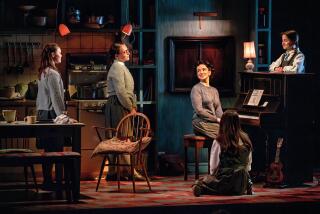‘Ice Cream Suit’--Touchstone for the Past and Present
The most important criticisms first.
In her “Wonderful Ice Cream Suit” review (Calendar, Sept. 18), Sylvie Drake said that my musical play was “mildly racist.”
Not so.
Here’s Hugo Quintana’s reaction in his review for La Opinion, certainly the most important Latino publication in Los Angeles:
”. . . a wonderful story, told with an enthusiasm that is contagious, and that not only respects the values of the Latino culture, but does so with warmth and sympathy.”
Drake continues: “When the guys come into the store to look for their ice cream suit, the older Anglo owners of the shop . . . assume they are about to be attacked. It’s a stuck-on nod to modernity . . .”
Not so. This scene, exactly as written, was in the original play in 1965, and appears in the short story, published in 1957. Therefore, it was not stuck on later to modernize the play.
Drake insists that my five young men are never more than stick figures, but I can think of few musicals in theater history where there was time to do more than sketch the lead characters. After all, musicals are fables, using metaphor in song and dance to flesh out the characters. My Villanazul, a poet-philosopher who is fearful of delivering his concepts, his poetry, in the Plaza, is finally encouraged, by wearing the Ice Cream Suit, to step forth and tell his need to cross the L.A. River:
Though there’s no water in the River,
There’s no River in the bed,
Yet he must swim across it,
For the River’s in his head.
He must walk on water, though there’s no water there, to reach the far side and survive.
Now that, to me, is character. Revealed not so much in talk or action before the song but through the very heart and soul of the song itself.
The same is true for all of the other characters who embody their metaphors in song or dance.
And then there is the Suit, the most important character at the center of the stage and their lives. It embodies all that we remember, all of us, from both sides of the River, in our growing lives. We have all worn the passed-down coats of our brothers and fathers. When I graduated from Los Angeles High School, I wore the suit of my uncle, killed in a holdup, with a bullet hole through the front of the coat and out the back. At graduation, my family was on government relief, receiving food while my father looked for work.
When it comes to the Suit, then, there is no yesterday and no today, only being poor, existing in a family that pretends not to be poor so as to get on with living tomorrow. I had to believe, skating around Hollywood in 1934, that some day I would go over the wall into Paramount or MGM studios. I went over the wall into screenwriting 15 years later. On the way, I bought my first suit with money earned selling newspapers on street corners, so that characters in my play need to wear the Suit to begin or restart their lives, to believe in themselves as lovers, philosophers or simple human beings.
The Suit, then, is the most important character. It is timeless. We are all shy or fearful about something. Sometimes we need a touchstone to make us move, take a chance, and at last become ourselves.
I wish Sylvie Drake would come back and see the play again. The Suit was right out there midstage, glowing in the dark, as the last curtain fell.
I don’t think she saw it.
See letters to Counterpunch, F4.
More to Read
The biggest entertainment stories
Get our big stories about Hollywood, film, television, music, arts, culture and more right in your inbox as soon as they publish.
You may occasionally receive promotional content from the Los Angeles Times.










